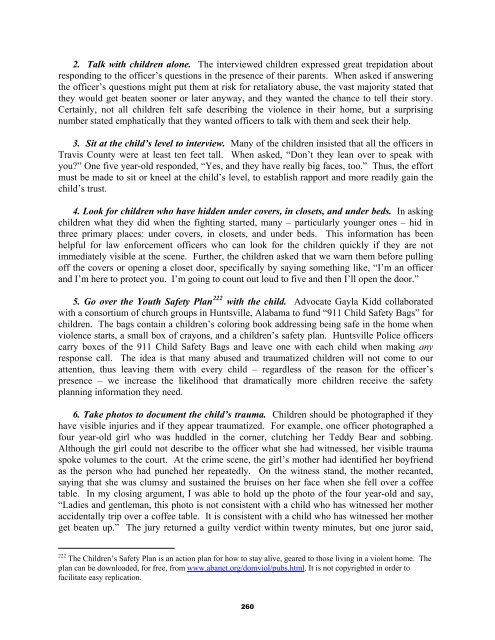A Judge’s Guide
A Judge’s Guide
A Judge’s Guide
Create successful ePaper yourself
Turn your PDF publications into a flip-book with our unique Google optimized e-Paper software.
2. Talk with children alone. The interviewed children expressed great trepidation about<br />
responding to the officer’s questions in the presence of their parents. When asked if answering<br />
the officer’s questions might put them at risk for retaliatory abuse, the vast majority stated that<br />
they would get beaten sooner or later anyway, and they wanted the chance to tell their story.<br />
Certainly, not all children felt safe describing the violence in their home, but a surprising<br />
number stated emphatically that they wanted officers to talk with them and seek their help.<br />
3. Sit at the child’s level to interview. Many of the children insisted that all the officers in<br />
Travis County were at least ten feet tall. When asked, “Don’t they lean over to speak with<br />
you?” One five year-old responded, “Yes, and they have really big faces, too.” Thus, the effort<br />
must be made to sit or kneel at the child’s level, to establish rapport and more readily gain the<br />
child’s trust.<br />
4. Look for children who have hidden under covers, in closets, and under beds. In asking<br />
children what they did when the fighting started, many – particularly younger ones – hid in<br />
three primary places: under covers, in closets, and under beds. This information has been<br />
helpful for law enforcement officers who can look for the children quickly if they are not<br />
immediately visible at the scene. Further, the children asked that we warn them before pulling<br />
off the covers or opening a closet door, specifically by saying something like, “I’m an officer<br />
and I’m here to protect you. I’m going to count out loud to five and then I’ll open the door.”<br />
5. Go over the Youth Safety Plan 222 with the child. Advocate Gayla Kidd collaborated<br />
with a consortium of church groups in Huntsville, Alabama to fund “911 Child Safety Bags” for<br />
children. The bags contain a children’s coloring book addressing being safe in the home when<br />
violence starts, a small box of crayons, and a children’s safety plan. Huntsville Police officers<br />
carry boxes of the 911 Child Safety Bags and leave one with each child when making any<br />
response call. The idea is that many abused and traumatized children will not come to our<br />
attention, thus leaving them with every child – regardless of the reason for the officer’s<br />
presence – we increase the likelihood that dramatically more children receive the safety<br />
planning information they need.<br />
6. Take photos to document the child’s trauma. Children should be photographed if they<br />
have visible injuries and if they appear traumatized. For example, one officer photographed a<br />
four year-old girl who was huddled in the corner, clutching her Teddy Bear and sobbing.<br />
Although the girl could not describe to the officer what she had witnessed, her visible trauma<br />
spoke volumes to the court. At the crime scene, the girl’s mother had identified her boyfriend<br />
as the person who had punched her repeatedly. On the witness stand, the mother recanted,<br />
saying that she was clumsy and sustained the bruises on her face when she fell over a coffee<br />
table. In my closing argument, I was able to hold up the photo of the four year-old and say,<br />
“Ladies and gentleman, this photo is not consistent with a child who has witnessed her mother<br />
accidentally trip over a coffee table. It is consistent with a child who has witnessed her mother<br />
get beaten up.” The jury returned a guilty verdict within twenty minutes, but one juror said,<br />
222 The Children’s Safety Plan is an action plan for how to stay alive, geared to those living in a violent home. The<br />
plan can be downloaded, for free, from www.abanet.org/domviol/pubs.html. It is not copyrighted in order to<br />
facilitate easy replication.<br />
260


